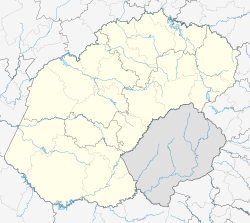Bethulie | |
|---|---|
 Nederduitse Gereformeerde Church, Grey Street, Bethulie | |
| Coordinates: 30°28′S25°58′E / 30.467°S 25.967°E | |
| Country | South Africa |
| Province | Free State |
| District | Xhariep |
| Municipality | Kopanong |
| Established | 1863 [1] |
| Government | |
| • Type | Municipality |
| • Mayor | Xolile Mathwa [2] (ANC) |
| Area | |
• Total | 37.0 km2 (14.3 sq mi) |
| Population (2023) [3] | |
• Total | 16,000 (approx.) |
| • Density | 430/km2 (1,100/sq mi) |
| Racial makeup (2011) | |
| • Black African | 81.6% |
| • Coloured | 9.3% |
| • Indian/Asian | 0.7% |
| • White | 8.0% |
| • Other | 0.4% |
| First languages (2011) | |
| • Xhosa | 43.8% |
| • Sotho | 31.0% |
| • Afrikaans | 18.9% |
| • English | 2.7% |
| • Other | 3.7% |
| Time zone | UTC+2 (SAST) |
| Postal code (street) | 9992 |
| PO box | 9992 |
| Area code | 051 |
Bethulie is a small sheep and cattle farming town in the Free State province of South Africa. It is located about 100 km/62 miles away from Springfontein. The name meaning chosen by God was given by directors of a mission station in 1829 which the town formed around. The mission building is the oldest settler built building still standing in the Free State. The town was also home to one of the largest concentration camps run by the British during the Boer War. The Dutch Reformed Church was built in 1862.




